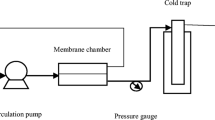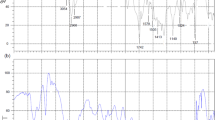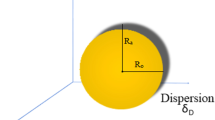Abstract
Applying waste polyethylene terephthalate (PET) bottles to fabricate membranes is a promising approach toward the circular economy and sustainable development. In the present study, waste PET bottles were applied to fabricate pervaporation (PV) membranes for the first time. Sorbitan trioleate (Span-85) was used as a hydrophobic additive, and the obtained membranes were examined in the PV separation of nitrobenzene (NB) as a hazardous material from water. Increased water contact angle, higher d-spacing (confirmed by X-ray diffraction spectroscopy), and decreased glass transition temperature (confirmed by differential scanning calorimetry) were observed for the membranes containing Span-85 and contributed to an increase in NB flux. The PET/1 wt% Span-85 membrane represented the highest separation factor (at 56,157.07) among the examined membranes, 332-fold as high as the neat PET membrane.











Similar content being viewed by others

References
Khan SU, Hassan T, Wasim M, Khan MQ, Salam A, Hassan SZU, Abbasi AMR, Mustafa T (2022) Valorization of recycled PET for yarn manufacturing and knitwear fabrics used for apparel applications. Polym Bull. https://doi.org/10.1007/s00289-022-04172-8
Baselga-Lahoz M, Yus C, Arruebo M, Sebastián V, Irusta S, Jiménez S (2022) Submicronic filtering media based on electrospun recycled PET Nanofibers: development, characterization, and method to manufacture surgical masks. Nanomaterials 12(6):925
Kalimuthu P, Kim Y, Subbaiah MP, Kim D, Jeon BH, Jung J (2022) Comparative evaluation of Fe-, Zr-, and La-based metal-organic frameworks derived from recycled PET plastic bottles for arsenate removal. Chemosphere 294:133672
Jang JY, Sadeghi K, Seo J (2022) Chain-extending modification for value-added recycled PET: a review. Polym Rev 62:860–889
Colorado HA, Saldarriaga L, Rendón J, Correa-Ochoa MA (2022) Polymer composite material fabricated from recycled polyethylene terephthalate (PET) with polyurethane binder for potential noise control applications. J Mater Cycles Waste Manag 24(2):466–476
Hassan MI, Kadir AA, Arzlan IS, Tomari MRM, Mardi NA, Hassan MF, Bakri A, Mohd Mustafa Al Bakri M, Nabiałek M, Jeż B (2022) Recycling of PET bottles into different types of building materials: a review. Arch Metall Mater 67:189–196
Hamid N, Shamsudin M (2022) Recycled plastic bottles as sustainable materials. In: Hassan R, Abdul Hamid NH, Arshad AK, Alisibramulisi A, Sidek MNM, Bhkari NM, Shaffie E (eds) Green Infrastructure. Springer, Singapore, pp 1–20
Kangavar ME, Lokuge W, Manalo A, Karunasena W, Frigione M (2022) Investigation on the properties of concrete with recycled polyethylene terephthalate (PET) granules as fine aggregate replacement. Case Stud Constr Mater 16:e00934
Qaidi S, Al-Kamaki YS, Al-Mahaidi R, Mohammed AS, Ahmed HU, Zaid O, Althoey F, Ahmad J, Isleem HF, Bennetts I (2022) Investigation of the effectiveness of CFRP strengthening of concrete made with recycled waste PET fine plastic aggregate. PLoS ONE 17(7):e0269664
Swetha Jayalakshmi J, Vijayalakshmi D (2022) A study on the comparison of fabric properties of recycled and virgin polyester denim. In: Muthu SS (ed) Sustainable approaches in textiles and fashion. Springer, Singapore, pp 61–86
Sava V, Bujoreanu LG, Badarau G (2021) Study concerning the obtaining of the filament for 3D printers from grains of recycled polyethylene terephthalate. Ştiinta Şi Ingineria Materialelor 67:41–53
Stoski A, Latczuk IF, Muniz EC, Almeida CAP (2022) Synthesis of Reinforced polyurethane composites from a matrix composed of recycled PET oligomers incorporating undeveloped Brazilian pine-fruit seeds. J Polym Environ 30(7):2955–2963
Zhang M, Ye W, Liao Z (2022) Preparation characterization and properties of flame retardant unsaturated polyester resin based on r-PET. J Polym Environ 30(5):1984–1994
Chan K, Zinchenko A (2022) Conversion of waste bottle PET to magnetic microparticles adsorbent for dye-simulated wastewater treatment. J Environ Chem Eng 10:108055
Farahani SD, Zolgharnein J (2022) Sulfate removal by barium-terephthalate MOF synthesized from recycled PET-waste using Doehlert design optimization. Inorg Chem Commun 140:109388
Bool RJA, Luwalhati GC, Tan NEY, Aquino AP, Maalihan RD (2022) On the use of metal-organic framework-based adsorbent from recycled PET bottles for Eriochrome Black T removal. Mater Today: Proc 65:3312–3320
Sharifian S, Asasian-Kolur N (2022) Polyethylene terephthalate (PET) waste to carbon materials: theory, methods and applications. J Anal Appl Pyrolysis 163:105496
Muthu Kumar N, Thilagavathi G, Karthikka M (2022) Development of recycled PET/comber noil nonwovens for thermal insulation application. J Nat Fibers 19(9):3233–3240
Arahman N, Fahrina A, Amalia S, Sunarya R, Mulyati S (2017) Effect of PVP on the characteristic of modified membranes made from waste PET bottles for humic acid removal. F1000Research 6:668
Rajesh S, Murthy ZVP (2014) Ultrafiltration membranes from waste polyethylene terephthalate and additives: synthesis and characterization. Quim Nova 37:653–657
Pulido BA, Habboub OS, Aristizabal SL, Szekely G, Nunes SP (2019) Recycled poly (ethylene terephthalate) for high temperature solvent resistant membranes. ACS Appl Polym Mater 1(9):2379–2387
Ali BTI, Widiastuti N, Kusumawati Y, Jaafar J (2022) Utilization of drinking water bottle waste as a sustainable and low-cost membrane material in water purification. Mater Today: Proc 65:3030–3036
Kusumocahyo SP, Ambani SK, Kusumadewi S, Sutanto H, Widiputri DI, Kartawiria IS (2020) Utilization of used polyethylene terephthalate (PET) bottles for the development of ultrafiltration membrane. J Environ Chem Eng 8(6):104381
Kusumocahyo SP, Ambani SK, Marceline S (2021) Improved permeate flux and rejection of ultrafiltration membranes prepared from polyethylene terephthalate (PET) bottle waste. Sustain Environ Res 31(1):1–11
Lu D, Babaniamansour P, Williams A, Opfar K, Nurick P, Escobar IC (2022) Fabrication and evaporation time investigation of water treatment membranes using green solvents and recycled polyethylene terephthalate. J Appl Polym Sci 139(35):e52823
Xiong Q, Chen H, Tian Q, Yue X, Qiu F, Zhang T, Wang A-B (2022) Waste PET derived Janus fibrous membrane for efficient oil/water emulsions separation. J Environ Chem Eng 10(5):108459
Zander NE, Gillan M, Sweetser D (2016) Recycled PET nanofibers for water filtration applications. Materials 9(4):247
Kiani S, Mousavi SM, Bidaki A (2021) Preparation of polyethylene terephthalate/xanthan nanofiltration membranes using recycled bottles for removal of diltiazem from aqueous solution. J Clean Prod 314:128082
Khashij M, Mokhtari M, Dalvand A, Haghiralsadat F, Fallahzadeh H, Salmani MH (2022) Recycled PET/metal oxides nanocomposite membrane for treatment of real industrial effluents: Membrane fabrication, stability, antifouling behavior, and process modeling and optimization. J Mol Liq 364:119966
Min X, Chu C, Luo Z, Ma J, Fu Y, Wei Z, Spinney R, Dionysiou DD, Xiao R (2022) Transformation of phenol and nitrobenzene by superoxide radicals: Kinetics and mechanisms. Chem Eng J 442:136134
Hu W, Wu F, Liu W (2022) Facile synthesis of Z-scheme Bi2O3/Bi2WO6 composite for highly effective visible-light-driven photocatalytic degradation of nitrobenzene. Chem Phys 552:111377
Yu H, Huang C, Zhang Y, Wu Y, Chen B, Sun J, Li X, Zhang J, Xu S, Cheng L, Zhang Y, Liu S, Zhao H (2022) Well-aligned TiO2 fibers and N-doped TiO2 fibers for efficient photocatalytic degradation of nitrobenzene in wastewater. J Mater Sci Mater 33(7):4145–4155
Quan X, Xu X, Yan B (2022) Facile fabrication of Tb3+-functionalized COF mixed-matrix membrane as a highly sensitive platform for the sequential detection of oxolinic acid and nitrobenzene. J Hazard Mater 427:127869
Svalova TS, Saigushkina AA, Verbitskiy EV, Chistyakov KA, Varaksin MV, Rusinov GL, Charushin VN, Kozitsina AN (2022) Rapid and sensitive determination of nitrobenzene in solutions and commercial honey samples using a screen-printed electrode modified by 1,3-/1,4-diazines. Food Chem 372:131279
Chen M, Huang X, Wang N, Wang T, Yang J, Wei Y, Dao X, Zhou L, Hao H (2022) Cu2O nanoparticles modified BiO2-x nanosheets for efficient electrochemical reduction of nitrate-N and nitrobenzene from wastewater. Sep Purif Technol 289:120728
Liu D, Liao Z, Hu Z, Shang E (2022) Electrochemical degradation of nitrobenzene wastewater: from laboratory experiments to pilot-scale industrial application. Catalysts 12(2):190
Lin TH, Toai PTD, Tinh NT, Phat LN, Huong LM, Viet ND, Dat NM, Nam HM, Phong MT, Hieu NH (2022) Fabrication of ceramic tube-supported tetraethyl-orthosilicate cross-linked polydimethylsiloxane membranes for separation of furfural–water mixture by pervaporation technology. J Appl Polym Sci 139:52380
Jafari A, Mortaheb HR, Gallucci F (2022) Performance of octadecylamine-functionalized graphene oxide nanosheets in polydimethylsiloxane mixed matrix membranes for removal of toluene from water by pervaporation. J Water Process Eng 45:102497
Rostovtseva V, Faykov I, Pulyalina A (2022) A review of recent developments of pervaporation membranes for ethylene glycol purification. Membranes 12(3):312
An X, Xu G, Xie B, Hu Y (2019) Structural tailoring of hierarchical fibrous composite membranes to balance mass transfer and heat transfer for state-of-the-art desalination performance in membrane distillation. J Mater Chem A 7(5):2376–2384
Kiani S, Mousavi SM, Saljoughi E, Shahtahmassebi N (2018) Preparation and characterization of modified polyphenylsulfone membranes with hydrophilic property for filtration of aqueous media. Polym Adv Technol 29(6):1632–1648
Bakhshandeh Rostami S, Saljoughi E, Mousavi SM, Kiani S (2022) Preparation of polyphenylsulfone/graphene nanocomposite membrane for the pervaporation separation of cumene from water. Polym Adv Technol 33(1):340–352
Miranmousavi HS, Saljoughi E, Mousavi SM, Kiani S (2021) Preparation and hydrophobicity modification of poly (vinylidene fluoride-co-hexafluoropropylene) membranes for pervaporation separation of volatile organic compound from water. Polym Compos 42(9):4684–4697
Dirin AM, Saljoughi E, Mousavi SM, Kiani S (2020) Pervaporation separation of isopropylbenzene from water using four different polymeric membranes: membrane preparation, modification, characterization, and performance evaluation. J Taiwan Inst Chem Eng 114:67–80
Almwli HHA, Mousavi SM, Kiani S (2021) Preparation of poly (butylene succinate)/polyvinylpyrrolidone blend membrane for pervaporation dehydration of acetone. Chem Eng Res Des 165:361–373
Zereshki S, Figoli A, Madaeni SS, Simone S, Jansen JC, Esmailinezhad M, Drioli E (2010) Poly(lactic acid)/poly(vinyl pyrrolidone) blend membranes: effect of membrane composition on pervaporation separation of ethanol/cyclohexane mixture. J Memb Sci 362(1):105–112
Aldas M, Pavon C, La Rosa-Ramírez D, Ferri JM, Bertomeu D, Samper MD, Lopez-Martinez J (2021) The impact of biodegradable plastics in the properties of recycled polyethylene terephthalate. J Polym Environ 29(8):2686–2700
dos Santos Ferreira JW, Marroquin JFR, Felix JF, Farias MM, Casagrande MDT (2022) The feasibility of recycled micro polyethylene terephthalate (PET) replacing natural sand in hot-mix asphalt. Constr Build Mater 330:127276
Pereao O, Laatikainen K, Bode-Aluko C, Fatoba O, Omoniyi E, Kochnev Y, Nechaev A, Apel P, Petrik L (2021) Synthesis and characterisation of diglycolic acid functionalised polyethylene terephthalate nanofibers for rare earth elements recovery. J Environ Chem Eng 9(5):105902
Silvia RC, Angel MF, Alejandro AS, Rodrigo NC, Aurelio RH, Eduardo BGJ, Calderón DEP (2021) Modification of banana starch (Musa paradisiaca L.) with polyethylene terephthalate: virgin and bottle waste. Carbohydr Res 508:108401
Fu X, Kong W, Zhang Y, Jiang L, Wang J, Lei J (2015) Novel solid–solid phase change materials with biodegradable trihydroxy surfactants for thermal energy storage. RSC Adv 5(84):68881–68889
Nasiraee M, Mousavi SM, Saljoughi E, Kiani S, Razmgar K (2021) Production of calcium nitrate crystals via membrane distillation crystallization using polyvinylidene fluoride/sorbitan trioleate membranes. Adv Powder Technol 32(5):1463–1471
Kato K, Walde P, Koine N, Imai Y, Akiyama K, Sugahara T (2006) Molecular composition of nonionic vesicles prepared from Span 80 or Span 85 by a two-step emulsification method. J Dispers Sci Technol 27(8):1217–1222
Fu Z, Liu M, Xu J, Wang Q, Fan Z (2010) Stabilization of water-in-octane nano-emulsion Part I: stabilized by mixed surfactant systems. Fuel 89(10):2838–2843
Agrawal S, Ingle N, Maity U, Jasra RV, Munshi P (2018) Effect of aqueous HCl with dissolved chlorine on certain corrosion-resistant polymers. ACS Omega 3(6):6692–6702
Zhang Y, Jia Y (2018) Synthesis of zeolitic imidazolate framework-8 on polyester fiber for PM 2.5 removal. RSC Adv 8(55):31471–31477
Johnson JE (1959) X-ray diffraction studies of the crystallinity in polyethylene terephthalate. J Appl Polym Sci 2(5):205–209
Gautam S, Dinda AK, Mishra NC (2013) Fabrication and characterization of PCL/gelatin composite nanofibrous scaffold for tissue engineering applications by electrospinning method. Mater Sci Eng C 33(3):1228–1235
Saedi S, Madaeni S, Shamsabadi AA, Mottaghi F (2012) The effect of surfactants on the structure and performance of PES membrane for separation of carbon dioxide from methane. Sep Purif Technol 99:104–119
Hosseini SS, Teoh MM, Chung TS (2008) Hydrogen separation and purification in membranes of miscible polymer blends with interpenetration networks. Polymer 49(6):1594–1603
Fann DM, Huang SK, Lee JY (1996) Kinetics and thermal crystallinity of recycled PET. I. Dynamic cooling crystallization studies on blends recycled with engineering PET. J Appl Polym Sci 61(8):1375–1385
Chowreddy RR, Nord-Varhaug K, Rapp F (2018) Recycled polyethylene terephthalate/carbon nanotube composites with improved processability and performance. J Mater Sci 53(9):7017–7029
Le Roux JD, Van Schalkwyk OG (1999) Incorporation of fluorinated surfactants into polysulfone films and asymmetric gas separation membranes. J Appl Polym Sci 71(1):163–175
Yan M, Lu Y, Li N, Zeng F, Wang Q, Bai H, Xie Z (2020) Hyperbranch-crosslinked S-SEBS block copolymer membranes for desalination by pervaporation. Membranes 10(10):277
Mousavinezhad SA, Mousavi SM, Saljoughi E (2020) Removal of 1, 2, 4-trimethylbenzene from water by pervaporation using styrene–butadiene–styrene (SBS) membrane incorporated with carbon black nanoparticles. Polym Eng Sci 60(2):257–266
Kiani S, Mousavi SM, Shahtahmassebi N, Saljoughi E (2015) Hydrophilicity improvement in polyphenylsulfone nanofibrous filtration membranes through addition of polyethylene glycol. Appl Sur Sci 359:252–258
Yang C, Tian X, Li D, Cao Y, Zhao F, Shi C (2017) Influence of thermal processing conditions in 3D printing on the crystallinity and mechanical properties of PEEK material. J Mater Process Technol 248:1–7
Liu S, Liu G, Zhao X, Jin W (2013) Hydrophobic-ZIF-71 filled PEBA mixed matrix membranes for recovery of biobutanol via pervaporation. J Memb Sci 446:181–188
Ma W, Li T, Jiang C, Zhang P, Deng L, Xu R, Zhang Q, Zhong J, Matsuyama H (2019) Effect of chain structure on the solvent resistance in aprotic solvents and pervaporation performance of PMDA and BTDA based polyimide membranes. J Memb Sci 584:216–226
Rychlewska K, Kujawski W, Konieczny K (2017) Pervaporative performance of PEBA and PDMS based commercial membranes in thiophene removal from its binary mixtures with hydrocarbons. Fuel Process Technol 165:9–18
Xu YM, Tang YP, Chung TS, Weber M, Maletzko C (2018) Polyarylether membranes for dehydration of ethanol and methanol via pervaporation. Sep Purif Technol 193:165–174
Beasley J, Reddy RS, Tchounwou P, Kafoury R (2012) Comparison of pollution levels on the Mississippi Gulf Coast during the 2010 Gulf BP oil spill to ecological and health-based standards. Rev Environ Health 27(2–3):67–74
Samdani AR, Mandal S, Pangarkar VG (2003) Role of and criterion for sorption selectivity in pervaporative removal of trace organics from aqueous solutions. Sep Sci Technol 38(5):1069–1092
Acknowledgements
Shirin Kiani was partially supported by a grant from Ferdowsi University of Mashhad (No. FUM-49216).
Funding
Shirin Kiani was partially supported by a grant from Ferdowsi University of Mashhad (Grant No. FUM-49216).
Author information
Authors and Affiliations
Contributions
SK: Conceptualization, Methodology, Validation, Investigation, Writing—Original Draft, Supervision, Funding acquisition, Visualization. SMM: Conceptualization, Methodology, Validation, Writing—Review & Editing, Resources, Supervision. SA: Investigation.
Corresponding author
Ethics declarations
Conflict of interest
There is no conflict of interest.
Additional information
Publisher's Note
Springer Nature remains neutral with regard to jurisdictional claims in published maps and institutional affiliations.
Rights and permissions
Springer Nature or its licensor (e.g. a society or other partner) holds exclusive rights to this article under a publishing agreement with the author(s) or other rightsholder(s); author self-archiving of the accepted manuscript version of this article is solely governed by the terms of such publishing agreement and applicable law.
About this article
Cite this article
Kiani, S., Mousavi, S.M. & Afrang, S. Preparation and Characterization of Polyethylene Terephthalate/Span-85 Pervaporation Membranes Using Waste Bottles for the Removal of Nitrobenzene from Water. J Polym Environ 31, 2968–2982 (2023). https://doi.org/10.1007/s10924-023-02784-3
Accepted:
Published:
Issue Date:
DOI: https://doi.org/10.1007/s10924-023-02784-3



